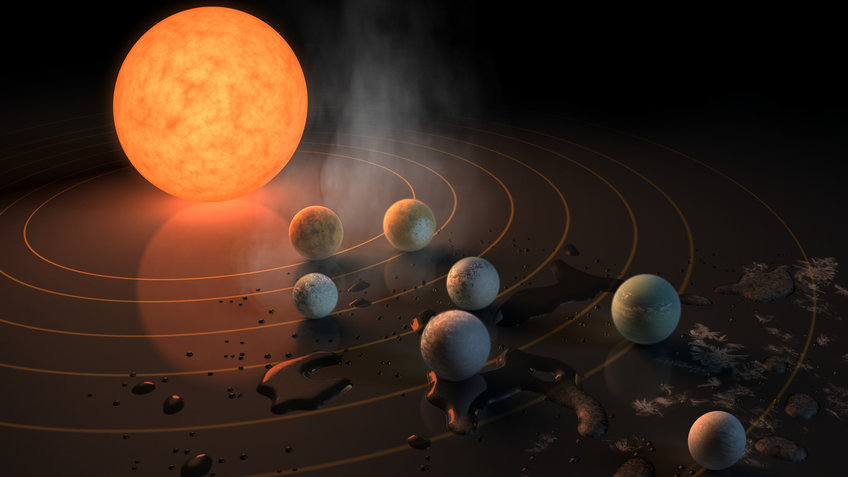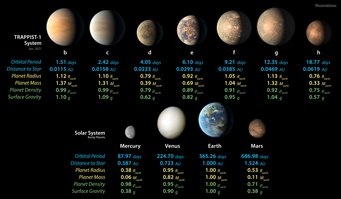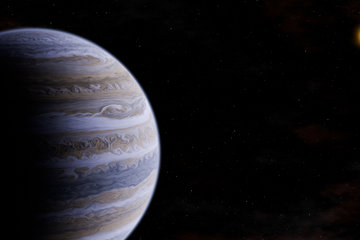Searching for an atmosphere on the rocky exoplanet Trappist-1 c
Observations with the James Webb Space Telescope reveal the appearance of the exoplanet
The exoplanet Trappist-1 c has almost the same size, temperature and irradiance as Venus. Observations with the James Webb Space Telescope, however, point to an atmosphere that is very different from that of Venus. By analysing the heat emitted from the planet, they conclude it may only have a tenuous atmosphere with minimal carbon dioxide. However, this measurement is also consistent with a barren rocky planet without any significant atmosphere. This work contributes to our understanding of how the atmospheres of rocky planets orbiting low-mass stars can withstand their strong stellar winds and intense ultraviolett radiation.

“The nearby Trappist-1 planetary system is currently the best candidate to study the atmospheres of rocky, Earth-like planets orbiting a red dwarf star,” says Sebastian Zieba, a student at the Max Planck Institute for Astronomy. He is the primary author of an article to appear in the journal Nature that reports on the results of Trappist-1 c. Located at a distance of about 40 light-years away, Trappist-1 hosts seven Earth-sized rocky planets, with up to three of them in the habitable zone. This means the radiation from the central star would produce enough heat to allow for water in a liquid form. However, Trappist-1 c, which the team observed with the James Webb Space Telescope, is not one of these planets. Instead, astronomers suspected that it was a twin of Venus.
Low-mass stars can erode planetary atmospheres
Although relatively cool on the outside, many such stars exhibit strong stellar winds and intense ultraviolett radiation over an extended period of their lifetime, potentially damaging and eroding their planets’ atmospheres. “We wanted to find out if Trappist-1 c may have escaped that fate and could have retained a substantial atmosphere, and perhaps even be similar to the planet Venus in the Solar System,” Zieba explains. The planet’s gravitational pull at the surface, which is 10 percent higher than that of Earth, should help retain its atmosphere. Like Venus, Trappist-1 c’s diameter and mass values are a close match with those of Earth. Furthermore, the radiation it experiences from its central star is nearly identical to that of Venus.
However, the task of characterizing the atmospheres of rocky, Earth-sized planets is a challenging endeavour, even for the James Webb Space Telescope. Therefore, the team combined their observations with model calculations to find the most likely range of atmospheric properties matching the data. The extent, pressure and composition of an atmosphere decides the temperature of a planet depending on the light it receives from its star. Conversely, the temperature determines how much infrared light the planet emits. This way, infrared measurements combined with models provide clues about the atmosphere and its composition.
Trappist-1 c is not like Venus

“We can definitely rule out a thick and Venus-like atmosphere,” says Laura Kreidberg, lead scientist of the James Webb observing program and a director at the Max Planck Institute for Astronomy. She also heads the Atmospheric Physics of Exoplanets Department. Defying the astronomers’ expectations, the temperatures “only” reach as high as 110 degrees Celsius (380 Kelvin), up to 390 degrees lower than on Venus. The infrared light emitted by Trappist-1 c does not match a Venusian atmosphere, rich in carbon dioxide causing a strong greenhouse effect.
In fact, the data is inconsistent with any kind of thick atmosphere rich in carbon dioxide, with surface pressures higher than ten times that of Earth. While results published on Trappist-1 b earlier this year showed it to be lacking any atmosphere, similar to Mercury, Trappist-1 c suggests that this planetary system is not a Solar System analogue.
Trappist-1 c may have a thin atmosphere
Does Trappist-1 c at least have a thin gas envelope? To explore that possibility, the scientists calculated the statistical likelihood of a set of atmospheric parameters to match the observations. The atmospheric model involved a range of surface pressures and mixtures of an oxygen dominated atmosphere with varying traces of carbon dioxide.
“We expect a high abundance of oxygen with some carbon dioxide for hot rocky planets orbiting low-mass stars,” explains Zieba. Planets like Trappist-1 c should possess an atmosphere containing carbon dioxide and water vapour early on in their evolution. Over time, the stellar radiation breaks up the water into hydrogen and oxygen. While the highly volatile hydrogen gradually escapes into open space, the heavier oxygen molecules remain, leading to an oxygen-rich atmosphere with traces of carbon dioxide.
As it turns out for Trappist-1 c, the model reflecting that assumption is consistent with a wide range of oxygen-carbon dioxide mixtures and surface pressures between one and one hundred percent of Earth’s sea level values. This result raises the hope for Trappist-1 c and other sufficiently heavy rocky planets around cool low-mass stars to sustain an atmosphere over a significant fraction of the stellar lifetime, as the star Trappist-1 is at least as old as the Sun.
Nevertheless, those results need verification with additional data. “Observations of thin rocky-planet atmospheres push James Webb to its limits,” Kreidberg admits. The measured signals are faint, and many properties are still unknown, leading to uncertainties. In the case of Trappist-1 c, atmospheric models are not the only ones that match the data. A barren rock with a surface layer of material weathered from stellar irradiation explains the observations equally well.
Observations are challenging even for JWST

While the James Webb Space Telescope is undoubtedly the most powerful space observatory ever launched, it is still very difficult to catch the heat signature of a small, moderately warm and rocky planet along with imprints of a surrounding atmosphere. Trappist-1 c, however, allows the astronomers a trick. The planet is tidally-locked, always facing its central star with the same side. This leads to two distinct hemispheres - one in constant day, and another in eternal night. The planet’s rotation is locked to its trajectory around the star, and as a result, both a day and a year last approximately 2.42 Earth-days on Trappist-1 c. In addition, its orbit is oriented in such a way that from our perspective it repeatedly passes in front of its star. At the halfway point of Trappist-1 c’s revolution, the star Trappist-1 covers the planet, completely hiding it from our telescopes for about half an hour. However, just before and after the planet vanishes, it presents its hot and fully-lit dayside for astronomers to observe. This is the signal the team was searching for, though any hint of a thin atmosphere would be diminutive at best.
Next steps
Additional James Webb observations are needed to distinguish between a plain rocky planet and a thin atmosphere. Signatures that appear when the planet turns its night side towards us could help. Then the thin atmospheric ring around the planet's body imprints the translucent starlight with signals that can provide information about its composition.
Another possibility would be a similar observation with the Extremely Large Telescope, a 39-metre telescope that is currentlz being built in Chile's Atacama Desert. It will have its first light before the end of this decade. It is the latest and largest addition to the European Southern Observatory's telescope fleet. The Extremely Large Telescopes's superior sensitivity could provide the deciding clue.
If astronomers confirm an atmosphere around Trappist-1 c, it would be an encouraging sign that atmospheres can survive the extreme influence of red dwarf stars after all.
MN














